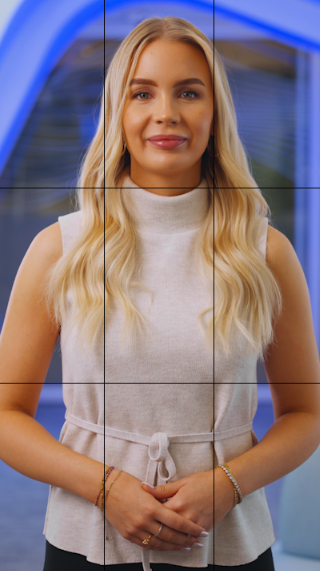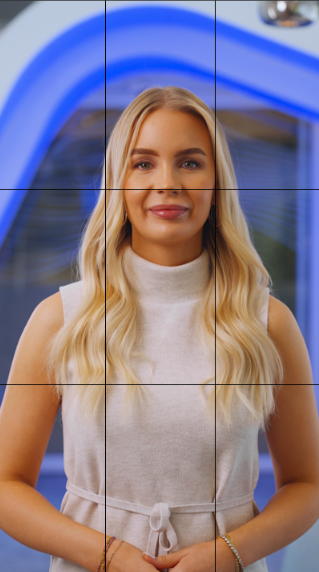Practical Tips 📱🎥
Now that you're ready to film, let's dive into some practical tips to make your video production process as smooth as possible, whether you're using a smartphone or a professional camera. In this section, we'll cover everything you need to create stunning, high-quality videos with minimal equipment and setup.
How to Make Amazing Short Videos Using a Smartphone in 2 Easy Steps
You Will Need:
- A smartphone with a high-quality camera
- A tripod
- An external microphone (optional but recommended)
- Lighting (optional)
Filming Equipment & Location
- Use the gear you already have
- Mobile device is perfectly fine
- Settings:
- 4K resolution at 25 fps or 24 fps
- Focal length of around 70mm – on an iPhone, this means using the 3x telephoto camera.
- Enable the Grid setting (see pics on slide 7)
- Use a tripod and position the camera at eye level
- Use a proper external microphone, we would recommend Rode Wireless mics for example (nappimikki lisäksi halutessaan, esim tämä tai tämä)
- Position the mic about 15 cm below your chin to get a soft sound
- Keep a few meters of distance between the camera and the subject
- Keep a few meters of distance between the subject and the background
- Light your subject well – use soft natural light or additional lighting. Avoid harsh shadows by diffusing the light (throw a sheet on the light for example to make it softer)
- Always clean the camera lens before shooting!
Framing & Composition
- Positioning objects and people within the frame - the Safe Zone
- Can we be two people in front of the camera? Yes, but the composition will be quite different AND it would be preferable to have two microphones
- How to film a widget video effectively
- Position the subject in the middle or crop a 1:1 video in post-production



How to Make Amazing Short Videos Using a DSLR or Mirrorless Camera in 3 Easy Steps
You Will Need:
- A DSLR or Mirrorless camera with a high-quality video mode
- A lens
- A tripod
- An external microphone
- Lighting (optional)
Step 1: Set Up the Tripod and Video Settings
- Choose a location with good lighting and a clean background.
- Place the tripod on a stable surface and adjust the height and angle of the camera for a balanced shot.
- Attach your camera to the tripod and adjust the angle (tilt the camera for the 9:16 format ratio if needed for vertical video).
- Choose an appropriate lens for the shot (we recommend a 28-70mm lens for versatility).
- Use Auto (A) mode if you prefer automatic settings. If you want more control, refer to the Annex for manual mode settings.
- Enable autofocus to ensure the subject stays sharp throughout the video. If the image is blurry, switch to manual focus (see Annex for more tips).
- Connect an external microphone to the camera for crisp, professional audio.
- Adjust the lighting to make sure both the subject and background are well-lit.
Step 2: Film the Video 🎥
- Frame the shot carefully and ensure the subject is well-lit and in focus.
- Press record and begin filming.
- Speak clearly and at a consistent volume.
- Keep the camera stable, avoiding any unnecessary movement.
- Record multiple takes to make sure you have the best possible footage for editing.
Annex: Manual Mode 🎛️
If Auto Mode (A) doesn’t meet your expectations, switch to Manual Mode (M) for full control over your camera’s settings.
- Set the video resolution to the highest available and choose a frame rate of at least 24 fps for a cinematic look, or 30 fps for standard video.
- Set the shutter speed to twice the frame rate (e.g., 1/50 for 24 fps).
- Adjust the ISO, aperture, and white balance to achieve the desired exposure and color balance.
- To fine-tune the focus, place an object where the subject will stand and adjust the focus until it’s sharp. If your camera has a Peaking feature, use it for easier focusing.
Quick Guide: 5 Easy Steps to Produce a Video 📝
- Choose your filming location: Make sure the location is well-lit with minimal background noise.
- Set up your phone on a tripod: A steady shot makes your video look more professional.
- Adjust your phone’s settings: For vertical videos, set your camera to a 9:16 aspect ratio.
- Frame your shot: Center your subject, keep them in focus, and use the rule of thirds for better composition.
- Press record and start filming: Speak clearly and ensure your microphone captures good audio.
With these tips, you’re ready to create professional-quality videos, no matter what equipment you're using. Happy filming! 🎉